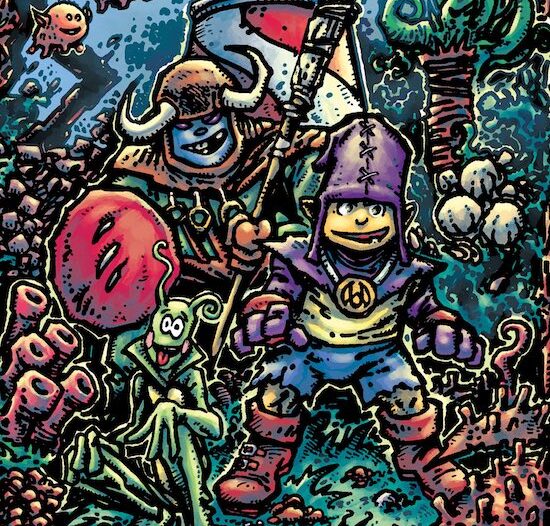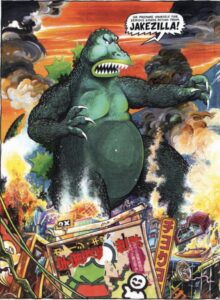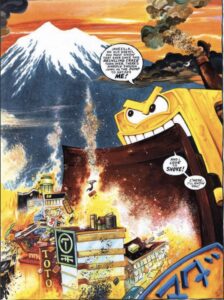
Review: ‘Underwhere’
Underwhere
Writers: Kevin Eastman and Paul Jenkins
Artists: Kevin Eastman and Mark Martin
IDW Publishing; $14.99
There are a handful of character design sketches in the back of this slim trade paperback volume that hint at the age and unusual provenance of its contents. Each of these drawings, many of which differ somewhat from the final versions of the characters that appear in the actual story, is signed “Eastman ’92″…as in “Kevin Eastman,” the co-creator of the Teenage Mutant Ninja Turtles comics-turned-cultural phenomenon, and “1992.”
Although IDW just re-released Underhwere (part of their fruitful relationship with the artist, who continues to contribute to their TMNT comics while they steadily release much of his backlog of comics—Turtle-related and otherwise), it was first self-published by Eastman in 1995.
ADVERTISEMENT
ADVERTISEMENT
According to the book’s unusual credits, Eastman created the story and characters and he shares a writing credit “with” Paul Jenkins, who worked with Eastman and Mirage Studios in the late eighties and early nineties. Jenkins would later go on to a rather successful writing career working for just about every publisher, although he’s probably still best known for his millennial work for Marvel.
As for the art, Eastman gets a “storyboards by” credit, while Mark Martin gets a “painted by” credit. Martin was, at the time, best known for his black-and-white Batman parody comic, Gnatrat, and he created a couple of issues of Teenage Mutant Ninja Turtles for Mirage, including a full-color parody of the original film. He has since gone on to contribute rather extensively to various kids comics, perhaps most notably the now-defunct Nickelodeon Magazine.
The interior art looks a lot like Martin’s, and not a whole lot like Eastman’s, but one of the fascinating hallmarks of the old Mirage comics was the way that the many hands contributing to a comic created an admixture of styles that was much more organic than the assembly-line process of writer-to-penciller-to-inker-to-letterer-to-colorist made familiar by DC and Marvel and their ilk. It is probably well worth noting that the cover of the book you see above is signed “Eastman ’17” and not only doesn’t much resemble the designs of “Eastman ’92,” but looks almost nothing like the bright, airy, soft and colorful work of Martin and his explosively exaggerated character design.
Now, Underwhere‘s journey to its final form, and just who did what in making it, may be of particular interest to adult readers, but younger readers are probably going to be more interested in just what it is exactly—and that’s probably why putting a new Eastman-drawn cover on the front wasn’t the very best idea in the world. I mean, we all know we’re not supposed to judge books by their covers, but that tends to be one of the criteria comics readers young and old use when approaching a graphic novel.
Underwhere feels a bit dated, but not necessarily because of the fact that it was created so long ago—rather, it’s that the things that seem like the inspiration for it are rather old. There’s definitely a Wizard of Oz-like aspect to it, as a child from the real world journeys to the titular land and meets a series of travelling companions one at a time on his quest.
The 1980s work of Jim Henson and his many collaborators seems to have inspired Eastman and Martin quite a bit as well, in particular Fraggle Rock, which similarly imagined a somewhat complex fantasy world that existed just beyond the edges of the real world. Some of the humanoid characters have a passing resemblance to nose-less, Muppet-esque characters, and our heroes even encounter an oracular, anthropomorphized mess named Hairball, which calls to mind Fraggle Rock‘s Trash Heap.
Underwhere‘s hero is Jacob, a little boy who we barely see anything of outside of silhouette in the “real world”; in fact, when we first meet him, we are inside one of his daydreams. He’s disturbed from his play by his mom, who is also barely seen on-panel, as she needs his help finding the deed to his grandfather’s house in order to prove that they own it now that he has passed away.
ADVERTISEMENT
ADVERTISEMENT
While searching, Jacob stumbles across a medallion and a strange ship that shrink and transform him, while sending him to the land of Underwhere, a suspiciously familiar world. There, Jacob is no longer a normal-looking human kid, but a big-eyed, orange-skinned elfin creature wearing vaguely medieval garb. He immediately meets Hugo, a grasshopper, and Klik Klik The Brave, a gruff, blue-skinned, self-styled knight armed with weaponry one might find in a junk drawer, like a button for a shield and a pencil for a spear.
Together they quest to find and stop Doc Static, who plans to turn all of Underhwere to dust, picking up additional allies (fairy forest queen Gina, a robot built from a can of corn named Bert the Wizbot) as they clash with Static’s forces, consisting of Raticals, goblins who ride upon rats using spats as saddles, and Roach Raiders, cartoon bug-men riding atop cartoony tarantulas.
It takes Jacob a bit longer than it will take most readers to realize that Underwhere is just his grandfather’s house, transformed into a fantasy land populated by the particularly tiny. His real world goal and his Underwhere quest naturally align, and by book’s end, there is perhaps some equivocation over whether or not any of it really happened or if, instead, it was a particularly engrossing daydream or play adventured spawned from Jacob’s own imagination.
In that regard, Underwhere is quite effective, a graphic novel that pretty perfectly captures the feeling of a child’s play, and how easy it is for young people to transform everything mundane around them into something more wondrous through their imaginations.
Filed under: All Ages
About J. Caleb Mozzocco
J. Caleb Mozzocco is a way-too-busy freelance writer who has written about comics for online and print venues for a rather long time now. He currently contributes to Comic Book Resources' Robot 6 blog and ComicsAlliance, and maintains his own daily-ish blog at EveryDayIsLikeWednesday.blogspot.com. He lives in northeast Ohio, where he works as a circulation clerk at a public library by day.
ADVERTISEMENT
ADVERTISEMENT
SLJ Blog Network
Top 10 Circulated Fiction of the 2023-24 School Year
Review of the Day: Not Quite a Ghost by Anne Ursu
It’s Time for More Mock Newbery Suggestions
Navigating the High School and Academic Library Policy Landscape Around Dual Enrollment Students
ADVERTISEMENT











